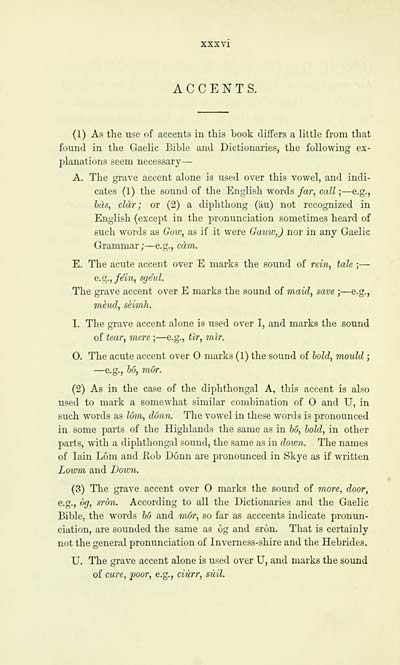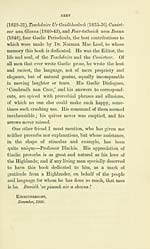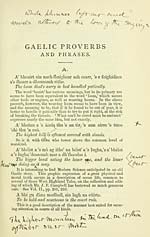Download files
Complete book:
Individual page:
Thumbnail gallery: Grid view | List view

ACCENTS.
(1) As the use of accents in this book differs a little from that
found in the Gaelic BiLle and Dictionaries, the following ex-
planations seem necessary —
A. The grave accent alone is nsed over this vowel, and indi-
cates (1) the sound of the English words far, call ; — e.g.,
has, clàr; or (2) a diphthong (au) not recognized in
English (except in the pronunciation sometimes heard of
such words as Gow, as if it were Gauw,) nor in any Gaelic
Grammar; — e.g., cam.
E. The acute accent over E marks the sound of rein, tale ;—
e.^.ffe'in, sge'ul.
The grave accent over E marks the sound of maid, save ; — e.g.,
mèicd, sèimh.
I. The grave accent alone is used over I, and marks the sound
of tear, mere ; — e.g., tlr, mlr.
0. The acute accent over marks (1) the sound of bold, mould ;
— e.g., bo, mor.
(2) As in the case of the diphthongal A, this accent is also
used to mark a somewhat similar combination of and U, in
such words as iCmi, dOnn. The vowel in these words is pronounced
in some parts of the Highlands the same as in ho, bold, in other
parts, with a diphthongal sound, the same as in down. The names
of Iain L6m and Kob Doun are pronounced in Skye as if written
Lowni and Dov:n.
(3) The grave accent over O marks the sound of more, door,
e.g., òg, sròn. According to all the Dictionaries and the Gaelic
Bible, the words ho and mor, so far as acccents indicate pronun-
ciation, are sounded the same as òg and sròn. That is certainly
not the general pronunciation of Inverness-shire and the Hebrides.
U. The grave accent alone is used over U, and marks the sound
of cure, poor, e.g., ciùrr, sùll.
(1) As the use of accents in this book differs a little from that
found in the Gaelic BiLle and Dictionaries, the following ex-
planations seem necessary —
A. The grave accent alone is nsed over this vowel, and indi-
cates (1) the sound of the English words far, call ; — e.g.,
has, clàr; or (2) a diphthong (au) not recognized in
English (except in the pronunciation sometimes heard of
such words as Gow, as if it were Gauw,) nor in any Gaelic
Grammar; — e.g., cam.
E. The acute accent over E marks the sound of rein, tale ;—
e.^.ffe'in, sge'ul.
The grave accent over E marks the sound of maid, save ; — e.g.,
mèicd, sèimh.
I. The grave accent alone is used over I, and marks the sound
of tear, mere ; — e.g., tlr, mlr.
0. The acute accent over marks (1) the sound of bold, mould ;
— e.g., bo, mor.
(2) As in the case of the diphthongal A, this accent is also
used to mark a somewhat similar combination of and U, in
such words as iCmi, dOnn. The vowel in these words is pronounced
in some parts of the Highlands the same as in ho, bold, in other
parts, with a diphthongal sound, the same as in down. The names
of Iain L6m and Kob Doun are pronounced in Skye as if written
Lowni and Dov:n.
(3) The grave accent over O marks the sound of more, door,
e.g., òg, sròn. According to all the Dictionaries and the Gaelic
Bible, the words ho and mor, so far as acccents indicate pronun-
ciation, are sounded the same as òg and sròn. That is certainly
not the general pronunciation of Inverness-shire and the Hebrides.
U. The grave accent alone is used over U, and marks the sound
of cure, poor, e.g., ciùrr, sùll.
Set display mode to: Large image | Transcription
Images and transcriptions on this page, including medium image downloads, may be used under the Creative Commons Attribution 4.0 International Licence unless otherwise stated. ![]()
| Early Gaelic Book Collections > J. F. Campbell Collection > Collection of Gaelic proverbs and familiar phrases > (44) |
|---|
| Permanent URL | https://digital.nls.uk/78588888 |
|---|
| Description | Volumes from a collection of 610 books rich in Highland folklore, Ossianic literature and other Celtic subjects. Many of the books annotated by John Francis Campbell of Islay, who assembled the collection. |
|---|
| Description | Selected items from five 'Special and Named Printed Collections'. Includes books in Gaelic and other Celtic languages, works about the Gaels, their languages, literature, culture and history. |
|---|

